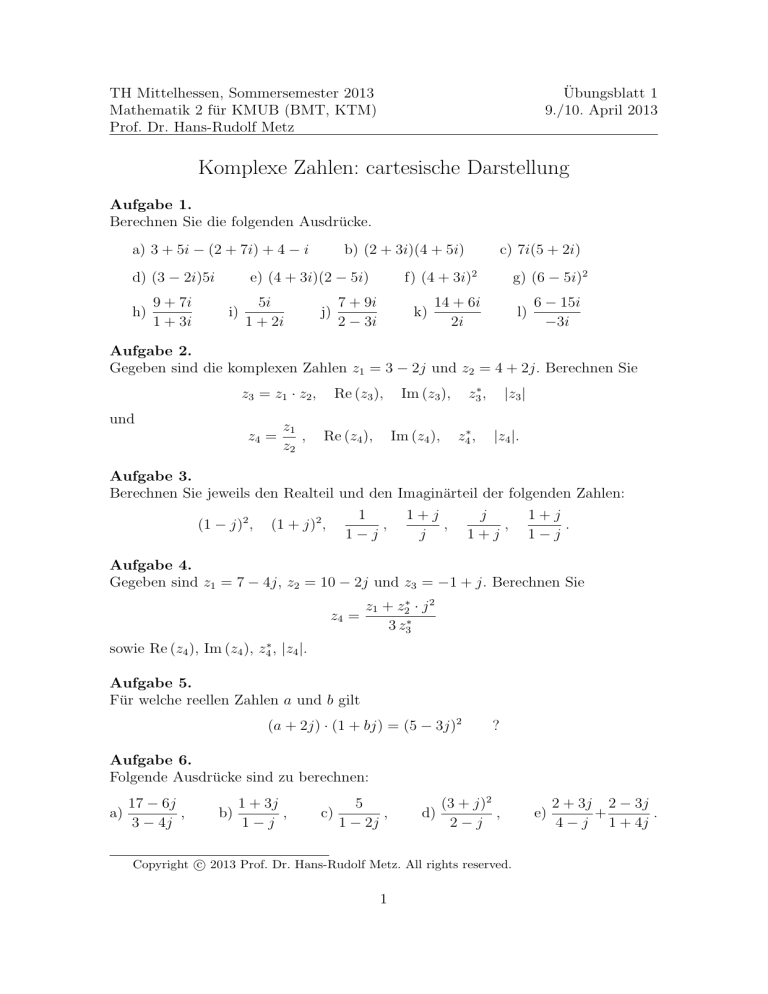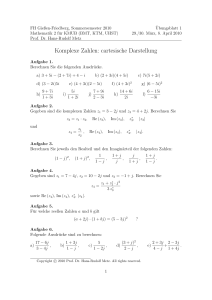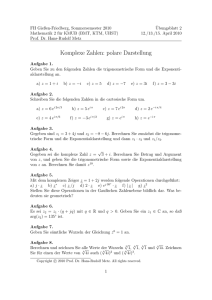Komplexe Zahlen: cartesische Darstellung - Benutzer
Werbung

TH Mittelhessen, Sommersemester 2013 Mathematik 2 für KMUB (BMT, KTM) Prof. Dr. Hans-Rudolf Metz Übungsblatt 1 9./10. April 2013 Komplexe Zahlen: cartesische Darstellung Aufgabe 1. Berechnen Sie die folgenden Ausdrücke. a) 3 + 5i − (2 + 7i) + 4 − i d) (3 − 2i)5i h) 9 + 7i 1 + 3i b) (2 + 3i)(4 + 5i) e) (4 + 3i)(2 − 5i) i) 5i 1 + 2i j) c) 7i(5 + 2i) g) (6 − 5i)2 f) (4 + 3i)2 7 + 9i 2 − 3i k) 14 + 6i 2i l) 6 − 15i −3i Aufgabe 2. Gegeben sind die komplexen Zahlen z1 = 3 − 2j und z2 = 4 + 2j. Berechnen Sie z3 = z1 · z2 , und z4 = z1 , z2 Re (z3 ), Re (z4 ), z3∗ , Im (z3 ), Im (z4 ), z4∗ , |z3 | |z4 |. Aufgabe 3. Berechnen Sie jeweils den Realteil und den Imaginärteil der folgenden Zahlen: (1 − j)2 , (1 + j)2 , 1 , 1−j 1+j , j j , 1+j 1+j . 1−j Aufgabe 4. Gegeben sind z1 = 7 − 4j, z2 = 10 − 2j und z3 = −1 + j. Berechnen Sie z4 = z1 + z2∗ · j 2 3 z3∗ sowie Re (z4 ), Im (z4 ), z4∗ , |z4 |. Aufgabe 5. Für welche reellen Zahlen a und b gilt (a + 2j) · (1 + bj) = (5 − 3j)2 ? Aufgabe 6. Folgende Ausdrücke sind zu berechnen: 17 − 6j , a) 3 − 4j 1 + 3j b) , 1−j 5 c) , 1 − 2j (3 + j)2 d) , 2−j c 2013 Prof. Dr. Hans-Rudolf Metz. All rights reserved. Copyright ⃝ 1 e) 2 + 3j 2 − 3j + . 4 − j 1 + 4j

